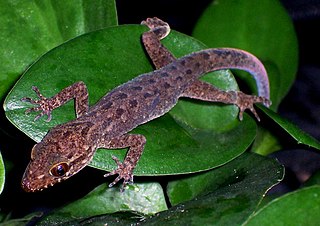
Cyrtodactylus is a diverse genus of Asian geckos, commonly known as bent-toed geckos, bow-fingered geckos, and forest geckos. The genus has 354 described species as of 2023, which makes it the largest of all gecko genera.

The Pentatomoidea are a superfamily of insects in the suborder Heteroptera of the order Hemiptera. As hemipterans, they possess a common arrangement of sucking mouthparts. The roughly 7000 species under Pentatomoidea are divided into 21 families. Among these are the stink bugs and shield bugs, jewel bugs, giant shield bugs, and burrower bugs.

The Arctiini are a tribe of tiger moths in the family Erebidae.
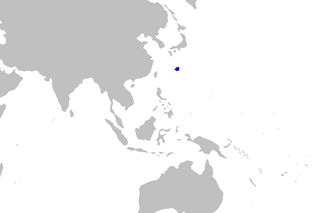
The rasptooth dogfish is a dogfish, found on the Kyushu–Palau Ridge in the northwest Pacific Ocean at depths of 360 m. Its maximum length is unknown. This species was originally described as Centroscyllium sheikoi, and subsequently allocated to the newly named genus Miroscyllium based on anatomical features not shared with other Centroscyllium. More recent molecular data suggest this species belongs to the genus Etmopterus, but as of June 2014 Miroscyllium sheikoi remains the valid name recognized by FishBase, the Catalog of Fishes World Register of Marine Species, and the IUCN
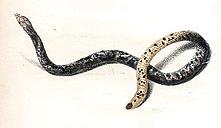
Rhinophis is a genus of nonvenomous shield-tail snakes found in Sri Lanka and South India. Currently, 24 species are recognized in this genus. Of the 24 species, 18 are endemic to Sri Lanka, while six are endemic to South India.

Clusiidae or "druid flies" is a family of small, thin, yellow to black acalyptrate flies with a characteristic antenna and with the wing usually partially infuscated. They have a cylindrical body. The head is round, the vertical plate reaches the anterior margin of the frons and the vibrissae on the head are large. The costa is interrupted near subcosta and the latter developed throughout length. Larvae are found in the bark of trees, the flies on trunks. The larvae are notable for their ability to jump. Males of many species in the subfamily Clusiodinae have been observed while engaged in lekking behaviour. There are hundreds of species in 14 genera found in all the Ecoregions, although most species occur in tropical regions. The type genus is Clusia Haliday, 1838.

Octocorallia is a class of Anthozoa comprising around 3,000 species of water-based organisms formed of colonial polyps with 8-fold symmetry. It includes the blue coral, soft corals, sea pens, and gorgonians within three orders: Alcyonacea, Helioporacea, and Pennatulacea. These organisms have an internal skeleton secreted by mesoglea and polyps with eight tentacles and eight mesentaries. As with all Cnidarians these organisms have a complex life cycle including a motile phase when they are considered plankton and later characteristic sessile phase.

Schistura is a genus of fish in the stone loach family Nemacheilidae native to the streams and rivers of the southern and eastern Asia. Some of these species are troglobitic.

The large-toothed shrew or Mexican large-toothed shrew is one of 77 species within the genus Sorex. Registered on the IUCN Red List as vulnerable with a decreasing population, the Mexican large-toothed shrew has been recorded only 14 times in seven locations. The shrew is a member of the red-toothed shrew subfamily Soricinae, and the more taxonomically defined tribe Soricini. Members of the latter category exhibit long tails relative to body size.

Dyspnoi is a suborder of harvestmen, currently comprising 43 extant genera and 356 extant species, although more species are expected to be described in the future. The eight families are currently grouped into three superfamilies: the Acropsopilionoidea, Ischyropsalidioidea, and Troguloidea.
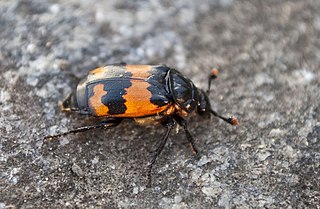
Nicrophorus investigator is a burying beetle first described by the Swedish naturalist Johan Wilhelm Zetterstedt in 1824.

Nicrophorus germanicus is a burying beetle described by Carl Linnaeus in his landmark 1758 10th edition of Systema Naturae. Males are larger than females and can reach a body length of 27 mm.
Djoko Tjahjono Iskandar is an Indonesian herpetologist who studies the amphibians of Southeast Asia and Australasia. He is a professor of biosystematics and ecology at Bandung Institute of Technology in West Java, Indonesia.
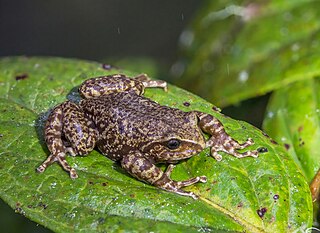
Pristimantis is a very large genus of frogs distributed in the southern Caribbean islands and in Central and South America from Honduras to northern Argentina and southern Brazil. With 596 described species, the genus had more species than any other genus of vertebrate animals. Many of these species genus are endemic to the Northwestern Andean montane forests ecoregion in north-western South America.
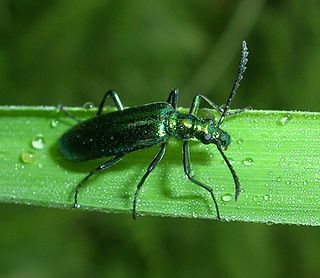
Prionoceridae is a small family of beetles, in the suborder Polyphaga. They form a group within the cleroid beetles and were formerly treated as a subfamily (Prionocerinae) within the family Melyridae. Very little is known of their life history but most species are pollen feeders as adults and occur in large numbers during spring or the host flowering season. Larvae are predatory or feed on decomposing wood.
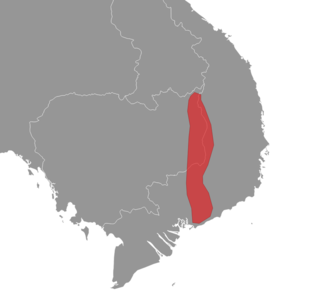
Crocidura phanluongi is a species of shrew in the genus Crocidura from southern Vietnam and nearby Cambodia. It is a somewhat small, gray shrew with an ecologically diverse distribution.

The Nemacheilidae, or stone loaches, are a family of cypriniform fishes that inhabit stream environments, mostly in Eurasia, with one genus, Afronemacheilus found in Africa. The family includes about 790 species.

Wanda Wesołowska is a Polish zoologist known for her work with jumping spiders. She has described more species of jumping spider than any contemporary writer, and is second only to Eugène Simon in the history of arachnology. Originally a student of ornithology, she developed an interest in jumping spiders while still a student at the Siedlce University of Natural Sciences and Humanities in the 1970s.
Sokolov's shrew is a species of mammal in the family Soricidae. It is endemic to Vietnam.
















